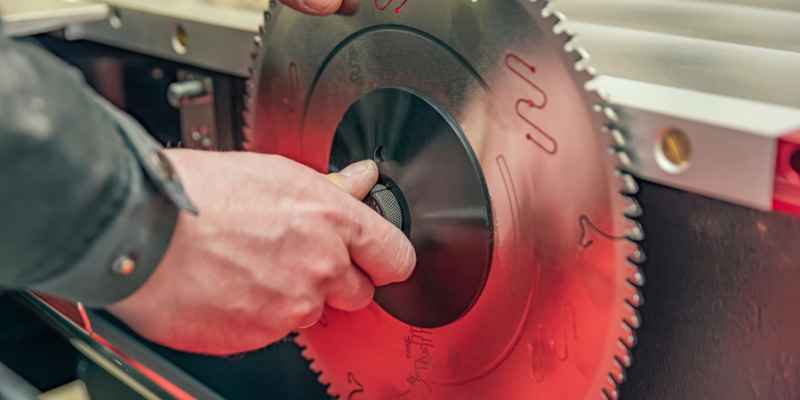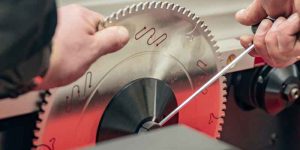To replace a circular saw blade, first, unplug the saw for safety. Then, using the provided wrench, loosen the arbor nut and remove the old blade.
Next, place the new blade onto the saw, ensuring the teeth face in the right direction. Tighten the arbor nut securely and you’re good to go. Are you ready to take your woodworking projects to the next level? Whether you’re a DIY enthusiast or a professional carpenter, knowing how to replace a circular saw blade is an essential skill.
A sharp and properly installed blade ensures clean and precise cuts, making your work more efficient and professional. In this guide, we’ll walk you through the simple steps to swap out your circular saw blade, empowering you to tackle your next cutting task with confidence. Let’s dive in and master this fundamental technique!
Introduction To Circular Saw Blade Replacement
Learn how to effortlessly replace a circular saw blade with our step-by-step guide. Easily swap out blades for a seamless cutting experience.
Replacing the blade on your circular saw is an essential maintenance task that ensures the tool’s optimal performance and your safety. Over time, saw blades can become dull or damaged, affecting the quality of your cuts and potentially causing accidents. In this guide, we will walk you through the process of replacing a circular saw blade, highlighting the importance of timely blade replacement and the precautions you should take before starting.
Importance Of Timely Blade Replacement
Regularly replacing your circular saw blade is crucial for maintaining the efficiency and effectiveness of your tool. A dull or worn-out blade can lead to uneven cuts, splintered edges, and increased strain on the motor. By promptly replacing the blade when needed, you can ensure clean and precise cuts, enhance your productivity, and extend the lifespan of your saw.
Safety First: Precautions Before Starting
Prior to replacing the circular saw blade, it is essential to prioritize safety to prevent any accidents or injuries. Here are some precautions to take:
- Disconnect the power source: Before starting any blade replacement, unplug the saw from its power source or remove the battery for cordless models. This step prevents accidental activation while you work on the blade.
- Wear protective gear: Put on safety glasses to shield your eyes from flying debris, and consider wearing gloves to protect your hands.
- Secure the saw: Use a workbench or clamp to secure the saw firmly, ensuring it remains stable during the blade replacement process.
- Inspect the saw: Before removing the old blade, inspect the saw for any signs of damage or loose parts. If you notice any issues, address them before proceeding.
- Follow the manufacturer’s instructions: Different saw models may have specific guidelines for blade replacement. Consult the user manual for your particular saw to ensure you follow the correct procedure.
By adhering to these safety precautions, you can minimize the risk of accidents and work confidently while replacing the circular saw blade.
Identifying When To Replace Your Blade
Knowing when to replace your circular saw blade is crucial to ensure the safety and efficiency of your cutting projects. By recognizing the signs of wear and tear and understanding the performance issues that indicate a need for replacement, you can maintain the quality of your work and prevent potential hazards.
Signs Of Wear And Tear
If you notice dullness, chipping, or warping on the teeth of the blade, it’s a clear indication that it needs replacement. Additionally, excessive vibration or unusual noises during operation can signal wear and tear.
Performance Issues Indicating A Need For Replacement
When the blade starts to burn the wood instead of cutting smoothly or produces rough and ragged edges, it’s time for a new blade. Slower cutting speed and increased resistance when pushing the saw through the material are also signs of a blade that needs to be replaced.
Selecting The Right Replacement Blade
Selecting the right replacement blade for your circular saw is crucial for efficient and safe cutting. Consider blade size, material, and teeth count to ensure it matches your saw and the task at hand. Always follow manufacturer instructions for proper blade replacement.
Blade Types And Their Applications
When it comes to selecting the right replacement blade for your circular saw, it’s important to consider the different blade types available and their specific applications. Choosing the appropriate blade type will ensure optimal performance and the best results for your cutting needs.
There are several blade types commonly used with circular saws, each designed for specific materials and cutting tasks. Here are the most common blade types and their applications:
- Rip-Cut Blades: These blades have fewer teeth and are ideal for making fast, long cuts along the wood grain. They are commonly used for ripping lumber or making straight cuts.
- Cross-Cut Blades: With more teeth and a finer tooth configuration, cross-cut blades are best suited for making clean, precise cuts across the wood grain. They are perfect for cutting plywood or other sheet materials.
- Combination Blades: As the name suggests, combination blades are versatile and can handle both rip-cutting and cross-cutting tasks. They have a mix of larger and smaller teeth, allowing them to perform well in various cutting applications.
- Specialty Blades: These blades are designed for specific materials and tasks. For example, there are blades specifically made for cutting metal, plastic, or laminate flooring. Using the right specialty blade will ensure efficient and accurate cuts.
Size And Compatibility Considerations
In addition to selecting the appropriate blade type, it’s crucial to consider the size and compatibility of the replacement blade. The size of the blade refers to its diameter, and it must match the specifications of your circular saw.
Circular saw blades come in various sizes, typically ranging from 6 to 12 inches in diameter. The size you choose depends on the capacity of your saw and the depth of cut required for your project. It’s essential to refer to your saw’s manual or manufacturer’s guidelines to determine the correct blade size.
Compatibility is another crucial factor to consider. Circular saw blades have a specific arbor size, which is the hole in the center that attaches to the saw’s spindle. It’s vital to ensure that the replacement blade’s arbor size matches the arbor size of your saw. Common arbor sizes include 5/8 inch and 1 inch.
By selecting the right replacement blade type, size, and ensuring compatibility, you can maximize the performance and efficiency of your circular saw. Remember to always prioritize safety and follow proper instructions when replacing the blade.
Tools And Materials Needed For Replacement
When it’s time to replace a circular saw blade, having the right tools and materials is crucial for a smooth and efficient process. By ensuring you have everything you need before you begin, you can minimize interruptions and complete the task with ease. In this section, we’ll outline the essential tools and materials required for replacing a circular saw blade.
List Of Essential Tools
Before you start replacing the circular saw blade, gather the following essential tools:
- Allen wrench: To remove the bolt securing the blade
- Circular saw blade: The replacement blade suitable for your saw
- Gloves and safety glasses: For personal protection
- Workbench or stable work surface: To support the saw during the blade replacement
- Wood block: To keep the blade from turning while loosening the bolt
- Shop vacuum or compressed air: For cleaning any debris
Preparing Your Workspace
Prior to replacing the circular saw blade, it’s essential to prepare your workspace. Here’s what you need to do:
- Secure the saw: Clamp it to the workbench or ensure it’s on a stable surface
- Disconnect the power: Unplug the saw or remove the battery to prevent accidental activation
- Clean the area: Remove any sawdust or debris to prevent interference with the blade replacement
Step-by-step Guide To Replacing The Blade
Learn the step-by-step process for replacing a circular saw blade. Start by disconnecting the power, then remove the blade guard and old blade, and finally, install the new blade and reassemble the saw. Always prioritize safety and follow the manufacturer’s instructions carefully for a smooth blade replacement process.
Circular saws are a staple in any DIY enthusiast’s tool collection. However, replacing a circular saw blade may seem like a daunting task for beginners. Luckily, it’s a simple process that can be done in a few easy steps. In this guide, we’ll take you through the process of replacing your circular saw blade step-by-step. We’ll cover securing the saw and removing the old blade, installing the new blade, and ensuring proper blade alignment.
Securing The Saw And Removing The Old Blade
Before replacing the blade, make sure the saw is unplugged from the power source. Then, use a wrench to loosen the bolt that secures the blade in place. Once the bolt is loose, remove the outer washer and blade. If the blade is stuck, gently tap it with a rubber mallet to loosen it before removing.
Installing The New Blade
Now that the old blade is removed, it’s time to install the new one. Make sure the new blade is the correct size for your saw before installing it. Then, slide the blade onto the arbor, making sure it’s flush against the blade spacer. Replace the outer washer and tighten the bolt with a wrench. Make sure the bolt is tight enough to secure the blade, but not too tight that it damages the blade or saw.
Ensuring Proper Blade Alignment
Once the new blade is installed, check the alignment to ensure it’s straight. To do this, use a straight edge to check the blade’s alignment with the saw base. If it’s not aligned, loosen the bolt and adjust the blade until it’s straight. Then, retighten the bolt and check the alignment again.
In conclusion, replacing a circular saw blade is a simple process that can be done in a few easy steps. By following this step-by-step guide, you can replace your saw blade with confidence, knowing that you’ve done it correctly. Remember to always follow safety precautions and refer to your saw’s user manual for specific instructions.
Safety Checks Post-installation

After replacing the circular saw blade, it is crucial to perform safety checks to ensure everything is in order. Inspect the blade for any damages or abnormalities, check the blade guard and depth adjustment, tighten all screws and bolts, and test the saw’s functionality before using it again.
Remember to prioritize safety to avoid any accidents.
After installing a new circular saw blade, it is crucial to perform safety checks to ensure proper functioning and prevent accidents.
Performing A Test Cut
To confirm the blade is correctly installed, perform a test cut on a scrap piece of wood to ensure smooth and precise cutting.
Inspecting For Blade Stability And Accuracy
Check the blade stability by ensuring it is securely tightened and visually inspect for any wobbling or misalignment.
Maintenance Tips To Prolong Blade Life
To prolong the life of your circular saw blade, it’s important to follow proper maintenance tips. When it’s time to replace the blade, start by disconnecting the saw from the power source. Use the blade wrench to loosen the arbor bolt, then carefully remove the old blade and replace it with a new one, ensuring it’s securely fastened.
Regular blade maintenance can extend its lifespan and ensure optimal performance.
Regular Cleaning And Storage Advice
Keep your circular saw blade clean after each use to prevent rust.
- Wipe the blade with a damp cloth and mild detergent.
- Dry it thoroughly before storing to avoid corrosion.
- Store the blade in a dry place away from moisture and dust.
Sharpening Your Blade For Extended Use
Regular sharpening enhances blade performance and longevity.
- Use a diamond blade sharpener for best results.
- Follow the blade manufacturer’s guidelines for sharpening.
- Ensure the teeth are uniformly sharp for smooth cuts.
Troubleshooting Common Issues
When replacing a circular saw blade, you may encounter common issues that affect performance. Here are solutions to troubleshoot these problems:
Addressing Blade Wobble
Blade wobbling can result from an unbalanced blade or loose arbor nut.
- Check blade for damage or debris causing imbalance.
- Ensure arbor nut is securely tightened to prevent wobbling.
Solving Power And Performance Problems
Issues with power and performance may stem from various factors:
- Inspect power source for adequate voltage supply.
- Clean saw blade and drive components for optimal performance.
- Sharpen or replace blade if cuts are not clean or effortless.

Frequently Asked Questions
How Often Should I Replace My Circular Saw Blade?
It is recommended to replace your circular saw blade when you notice decreased cutting performance or blade dullness. Regularly inspecting the blade for wear and tear can help determine when a replacement is needed.
What Safety Precautions Should I Take When Replacing The Saw Blade?
Ensure the saw is unplugged, wear protective gloves and eyewear, and follow the manufacturer’s instructions carefully. Avoid touching the blade directly and use proper tools to secure the blade during replacement to prevent accidents.
Can I Use Any Blade To Replace My Circular Saw Blade?
No, it’s crucial to use a blade that is compatible with your specific circular saw model. Check the saw’s manual for recommended blade types and sizes to ensure proper fit and optimal performance.
How Do I Know If The Circular Saw Blade Is Installed Correctly?
After installing the new blade, ensure it is securely tightened and aligned with the saw’s arbor. Check for any wobbling or looseness in the blade before operating the saw to prevent potential hazards.
Conclusion
To sum up, replacing a circular saw blade is an easy process that requires safety precautions and the right tools. Always ensure the saw is unplugged, and the blade is compatible with the saw. Remember to inspect the blade, clean the arbor, and tighten the blade securely.
By following these steps, you can quickly and safely replace your circular saw blade and continue with your DIY projects. Happy sawing!


